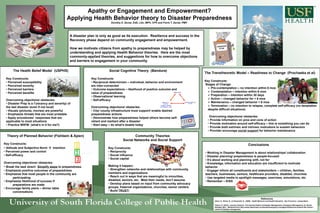
Pnwbha Poster 2012
- 1. Apathy or Engagement and Empowerment? Applying Health Behavior theory to Disaster Preparedness Dorothy D. Zeviar, EdD, LAc, MPH, CPH and Fiorin T. Zeviar, PMP A disaster plan is only as good as its execution. Resilience and success in the Recovery phase depend on community engagement and empowerment. How we motivate citizens from apathy to preparedness may be helped by understanding and applying Health Behavior theories. Here are the most commonly-applied theories, and suggestions for how to overcome objections and barriers to engagement in your community. The Health Belief Model (USPHS) Social Cognitive Theory (Bandura) The Transtheoretic Model – Readiness to Change (Prochaska et al) Key Constructs: Key Constructs: • Perceived susceptibility • Reciprocal determinism – individual, behavior and environment Key Constructs: • Perceived severity are inter-connected Stages of Change: • Perceived barriers • Outcome expectations – likelihood of positive outcome and Pre-contemplation – no intention within 6 mos • Perceived benefits value of preparedness Contemplation – intention within 6 mos • Observational learning Preparation – intention within 30 days Overcoming objections/ obstacles: • Self-efficacy Action – changed behavior for < 6 mos • Disaster Prep is a f (recency and severity) of Maintenance – changed behavior > 6 mos the last disaster (even if not local) Overcoming objections/ obstacles: Termination – no intention to relapse, complete self-efficacy (no temptation • Visuals (pictures, movies) are powerful • City/ county infrastructure must support/ enable desired despite difficult situations) • Emphasize threats that are most probable preparedness actions • Apply procedures/ responses that are • Demonstrate how preparedness helped others become self- Overcoming objections/ obstacles: applicable to most situations reliant and resiliant after a disaster • Provide information on pros and cons of action • Practice WIIFM (what’s in it for me?) • Start easy – do what’s doable today • Provide motivation around self-efficacy – this is something you can do • Provide both extrinsic and intrinsic motivators to sustain behaviors • Provide/ encourage social support for behavior maintenance Theory of Planned Behavior (Fishbein & Ajzen) Community Theories Social Networks and Social Support Key Constructs: Conclusions • Attitude and Subjective Norm Intention Key Constructs: • Perceived power and control • Reciprocity • Working in Disaster Management is about relationships/ collaboration • Self-efficacy • Social influence • Disaster planning/ preparedness is people-focused • Social capital • It’s about working and planning with, not for Overcoming objections/ obstacles: • Knowledge, information and education are insufficient to motivate • Break the task down! Simplify steps to preparedness Making it happen: behavior • Emphasize positive outcomes of preparedness • Strengthen networks and relationships with community • Engage/ inform all constituents and stakeholders – children, families, • Emphasize that most people in the community are members and organizations teachers, businesses, seniors, healthcare providers, disabled, churches participating • Reach out in ways that are meaningful to minorities, • Use targeted media to spotlight messages, exercises, simulations, etc • Emphasize likelihood of success if disabled, seniors, etc. Meet their needs, don’t assume. • Remember – KISS preparations are made • Develop plans based on input from community advocacy • Encourage family plans – dinner table groups, fraternal organizations, churches, senior centers. conversations • Build TRUST! References Glanz, K., Rimer, B., & Viswanath, K. (2008). Health Behavior and Health Education. San Francisco: Jossey-Bass. Hutton, D. (2012). Lessons Unlearnt: The (Human) Nature of Disaster Management, Emergency Management, Dr. Burak Eksioglu (Ed.). Retrieved from http://www.intechopen.com/books/emergency-management/lessons-unlearnt-the-human- nature-of-disaster-management